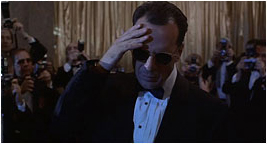AUTHOR OF 'BONFIRE OF THE VANITIES' REFUSED TO BLAME DE PALMA FOR FAILED ADAPTATION
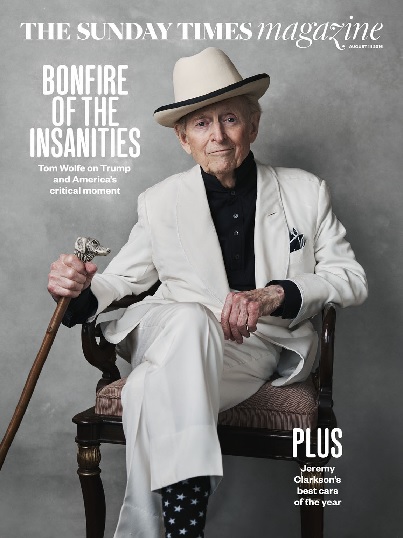 Tom Wolfe, whose "novel of the 1980s", The Bonfire Of The Vanities, was adapted into the film directed by Brian De Palma, died Monday in a hospital in New York. He was 88.
Tom Wolfe, whose "novel of the 1980s", The Bonfire Of The Vanities, was adapted into the film directed by Brian De Palma, died Monday in a hospital in New York. He was 88.Wolfe's novel, which had originally been serialized in Rolling Stone magazine, was published in 1987 and quickly became a well-loved, sensational bestseller. De Palma had recently had one of his biggest successes with The Untouchables, and signed on to direct the film version, which was to star Tom Hanks. The film was a high-profile endeavor, covered regularly in the New York and Hollywood press, and De Palma decided to allow Julie Salamon access to all of the goings-on as the film was being made. The resulting book, The Devil's Candy, stands today as a key text about the inside of an expensive Hollywood production. In her book, Salamon interviews Wolfe as the film is being made, and, later, after he has seen the film. Here's that first interview, from her prologue:
That morning the slender, contradictory man was eating grain cereal with stewed fruit and speaking in a thoughtful, slightly formal fashion about how the people from Hollywood were progressing with the movie version of The Bonfire of the Vanities. He mentioned diplomatically that they were being attentive to details."I must confess I get my shoes made at New & Lingwood," Wolfe said, dropping the name of the London fabricator of two-thousand-dolloar-a-pair men's shoes with his cultivated mixture of snobbery and modesty. "And the salesman was here in New York, and he said that Tom Hanks had arrived and wanted two pairs of shoes for the movie -- Tom Hanks or whoever was buying shoes for him -- and asked the salesman what kind should we get? And the salesman says, 'Well, in the book it says half-brogues,' and the movie person says, 'Okay, give us those.' I was rather impressed by that because, unless they make a point of it in the script to have the camera focus on the shoes, who's going to know? You have to have a very picky eye like myself to sit around and figure out where the shoes are from. They seem to be concerned with accuracy -- inn certain respects."
He wasn't willing to criticize the moviemakers -- just yet. "I think it's bad manners in the Southern sense to be sharp and critical of it," he said. "I did cash the check." However, with his good Southern manners the author had made it clear to the Hollywood people right after he accepted the $750,000 they paid him for the rights to his book that he didn't want to have anything to do with the making of their movie.
"To tell the truth, I've never wanted to write any script based on something I've done," he said. "From my standpoint it's too bad that movies don't run nine or ten hours. The way I constructed the book, almost every chapter was meant to be a vignette of something else in New York as well as something that might advance the story, and to me one was as important as the other."
The author paused briefly. "It's a fairly simple story. It's not a complicated story. But I wanted there to be all these slices, one after another. Not that I gave very much thought to how the movie could be made, but I never could see how you could do that."
In the final chapter of The Devil's Candy, Salamon again interviews Wolfe, who has just watched De Palma's film via a pre-opening day screening for the author and friends:
Tom Wolfe cringed over the movie, just as he'd cringed the first time he saw "The Right Stuff." He saw "Bonfire" two more times after that, hoping he might like it better. He didn't.
He never violated his rule of public silence on the subject of "Bonfire of the Vanities." He hinted that he didn't care for it much, but the worst thing he said was that "the great thing about selling a book to the movies is that nobody blames the author." Wolfe realized that in some way he was a collaborator in this venture, and that he was better off being polite about it all. He also recognized the fact that his books now had a bad track record in Hollywood and it was a good idea to be polite.
In private he confessed that he was dismayed by the picture, that he really disliked the writing in it. "My feeling is that Hollywood rules are always wrong," he said. "Everybody in Hollywood hates to think about writing. It's so uncompromisable in a sense. There's no easy way to improve it. It's so fundamental. You can't make it better with a better deal."
He sympathized with De Palma's dilemma and couldn't see any way to condense the book himself. He had liked the director's idea to use "Dr. Strangelove" as his model for "Bonfire of the Vanities." But Wolfe felt De Palma didn't pull it off. "Dr. Strangelove," he felt, was a bitter farce, with the emphasis on bitter. The director, Stanley Kubrick, had only one message and it was antiwar. In every scene Kubrick set the business of war against the idiocy of the people making the war.
Wolfe couldn't really understand what kind of farce De Palma wanted "Bonfire" to be. "It wasn't a bitter farce and it wasn't a bedroom farce and it wasn't a sweet farce or an agreeable movie," he said. "As far as I can tell they didn't take on a point of view and cleave to it. I'd be pretty hard put to tell you what the point of view is."
And though he understood that few people would believe it, Wolfe (the man who made up phrases like "Heh-heggggggggggggggggghhhhhhhhhhhhhhh!") thought the film was too exaggerated. "It was as if Brian De Palma said, 'Well, I've got to do something extraordinary to pull this off in two hours, so I'm going to try all kinds of things. I'm going to try this "Dr. Strangelove" approach. I'm going to try the most extreme camera angles I've ever used.'"
Wolfe sighed. "If you're going to exaggerate, it has to be done just so, as in 'Dr. Strangelove.' The slightest false note can boomerang. I hesitate to find a great deal of fault with what was done because it was a tough problem to do this thing in two hours. De Palma took a chance. It really didn't pan out."
From today's obit by Rolling Stone's Tim Grierson:
Born in March 1931, Thomas Kennerly Wolfe Jr. grew up in Richmond, Virginia, holding onto his genteel Southern accent all his life. Attending Washington and Lee University, he studied English literature – there was no writing major – and edited the school newspaper's sports section, along the way co-founding the college's literary magazine Shenandoah. After receiving his doctorate at Yale, he worked as a reporter in Springfield, Massachusetts before moving to The Washington Post and then landing at the New York Herald Tribune, whose brash reporting style was summed up by its motto: "Who says a good newspaper has to be dull?" While there, he wrote for the paper's Sunday magazine, which would later become New York magazine, an upstart rival to the more refined New Yorker.But Wolfe's first major breakthrough came in 1963 with a piece he pitched Esquire about Southern California's world of custom cars. After doing the reporting, though, he panicked about how to write the piece. On the advice of his editor, he sent over his typed-up notes, and the vivid, stream-of-consciousness observations became "There Goes (Varoom! Varoom!) That Kandy-Kolored Tangerine-Flake Streamline Baby," one of the landmark documents in the formation of New Journalism — a flashy, giddy prose style whose champions, including idiosyncratic writers like Hunter S. Thompson, were charting the country's changing, turbulent mood during the Sixties.
The techniques Wolfe brought to "Kandy-Kolored" – you-are-there portraiture, inspired digressions, obscene amounts of exclamation marks and italics – would be his trademarks in subsequent works, perhaps most memorably in his 1968 nonfiction book The Electric Kool-Aid Acid Test, which didn't just profile Kesey but also the LSD counterculture at large. (Wolfe himself didn't partake in the hallucinogen. "I felt it was really far too dangerous to take a chance," he said in 2016, "and they didn't try to pressure me.")
Wolfe always dove into unique ecosystems in order to present a macro view of American life. 1979's The Right Stuff, which started as a series of pieces in Rolling Stone about the Mercury Seven astronauts, became a commentary on the country's can-do spirit and the breadth of its ambition. No matter the topic, Wolfe learned quickly that trying to blend in with his subjects actually hurt his reporting — pretending to know more than he did kept him from learning the basics of the worlds he was embedded in.
"People really don't want you to try to fit in," he said in a 1980 interview with Rolling Stone. "They'd much rather fill you in. People like to have someone to tell their stories to. So if you're willing to be the village information gatherer, they'll often just pile material on you. My one contribution to the discipline of psychology is my theory of information compulsion. Part of the nature of the human beast is a feeling of scoring a few status points by telling other people things they don't know. So this does work in your favor."
In that same interview, he mentioned that he was considering writing his first novel. "I'm doing something that I've had on my mind for a long time, which is a Vanity Fair book about New York, à la Thackeray," he offered, later adding, "[N]ovelists themselves hardly touch the city. How they can pass up the city, I don't know. The city was a central — character is not a very good way to put it, but it was certainly a dominant theme — in the works of Dickens, Zola, Thackeray, Balzac. So many talented writers now duck the city as a subject. And this is one of the most remarkable periods of the cities."
After years of research and reporting, Wolfe achieved his lofty goal by publishing The Bonfire of the Vanities, an epic, swaggering tome that began as installments in Rolling Stone. The book introduced the world to Sherman McCoy, a wealthy and morally corrupt bond trader who, in another lively Wolfe turn of phrase, was a "Master of the Universe" during Wall Street's giddy Eighties boom. Receiving glowing reviews and enjoying phenomenal sales, The Bonfire of the Vanities tackled not just New York but also racism, masculinity, economic inequality, a broken justice system and the tabloid press — all the while being wickedly funny and unexpectedly moving. It was quintessential Wolfe: knee-deep in the messy vibrancy of American life but sharply insightful about the country's contradictions and shortcomings.
"When I was writing that book, it was with a spirit of wonderment," he confessed later. "I was saying [excitedly], 'Look at these people! Look at what they're doing! Look at that one! Look at that one!' It was only after I finished and read it over that I see that there is a cumulative effect that leads to [a dark reading of the book]."
Updated: Tuesday, May 15, 2018 11:18 PM CDT
Post Comment | Permalink | Share This Post




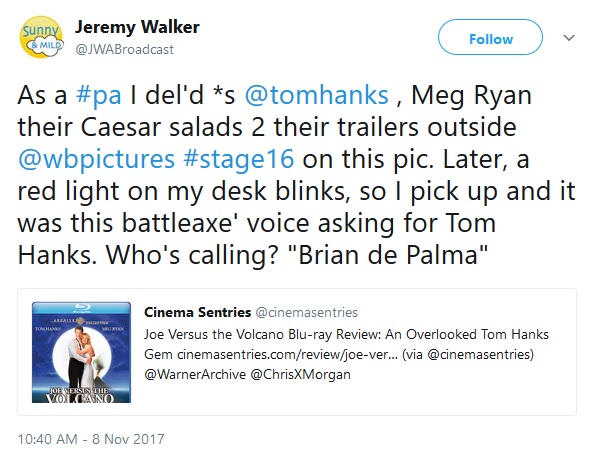
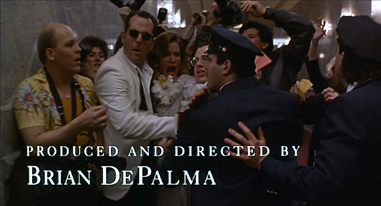 On Friday,
On Friday, 
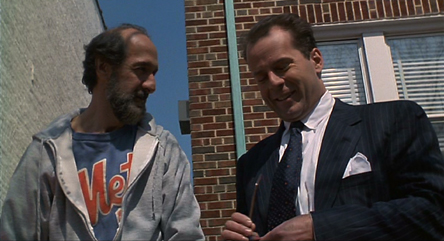 Richard Libertini, who had a brief role as a high school teacher in Brian De Palma's The Bonfire Of The Vanities, died January 7. He was 82. According to the
Richard Libertini, who had a brief role as a high school teacher in Brian De Palma's The Bonfire Of The Vanities, died January 7. He was 82. According to the  The photo at left (taken by Bruce Gilbert) shows Tom Wolfe, seated in between U.S. Attorney Preet Bharara and moderator Thane Rosenbaum, discussing his novel The Bonfire Of The Vanities on stage following a screening of Brian De Palma's film adaptation. The screening, which took place this past Tuesday (October 27th), was part of the 10th Annual Forum on Law, Culture & Society Film Festival. A video of the discussion is available at
The photo at left (taken by Bruce Gilbert) shows Tom Wolfe, seated in between U.S. Attorney Preet Bharara and moderator Thane Rosenbaum, discussing his novel The Bonfire Of The Vanities on stage following a screening of Brian De Palma's film adaptation. The screening, which took place this past Tuesday (October 27th), was part of the 10th Annual Forum on Law, Culture & Society Film Festival. A video of the discussion is available at  Thanks to Hugh for letting us know that Tom Wolfe will speak following a screening of The Bonfire Of The Vanities, Brian De Palma's film adaptation of Wolfe's most famous novel. The event will take place at 7pm October 27th, at
Thanks to Hugh for letting us know that Tom Wolfe will speak following a screening of The Bonfire Of The Vanities, Brian De Palma's film adaptation of Wolfe's most famous novel. The event will take place at 7pm October 27th, at 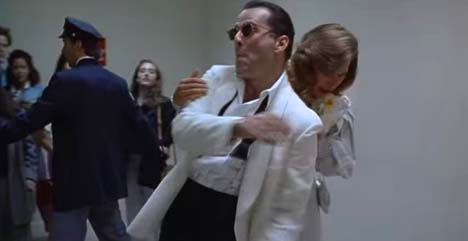
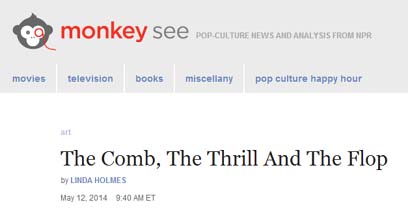 In a
In a 